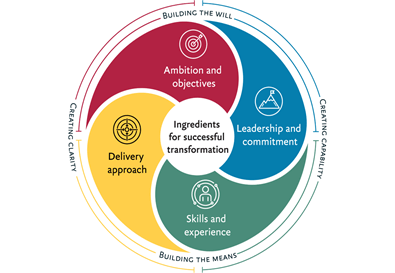This theme recurs across all industry sectors, but it is particularly relevant when there is a significant amount of change and uncertainty, which unfortunately for many organisations is now the norm as economic, political and technology shifts continue to throw up new challenges.
However, there are some simple steps organisations can take which will significantly improve the way in which they communicate and, therefore, operate.
Recognising the importance of middle management
What good is a vision statement or a roadmap for the future if only the leadership team understand it?
The most frequent blockages in information cascading through an organisation come at the middle management level. These are the individuals that have access to leadership teams, but do not always communicate what they know to others. This divide between the top and bottom of an organisation makes it impossible for there to be a sense of working together, or even a genuine understanding for employees as to what the value of their job is.
Leaders understand that they must act as role models, but managers have an equally important part to play. In fact, if you ask the majority of employees who influences them the most in the workplace, the answer would be their line manager.
Leadership teams must understand that it is not enough that they communicate; they need to create an environment where every manager understands that communication is a key part of their job because these same managers are the key conduit of information flowing around the organisation. This flow must include providing feedback to the leadership team, who need to embrace it if they are to avoid the perception that they are too distant from the coalface.
Creating a structure for communication
One key reason why communication in an organisation can often be ineffective is due to a lack of formal structure.
The pressures of day-to-day work can leave managers with little time to reflect and think about what they should be communicating and how it is best delivered. They may also not give it sufficient priority – perhaps seeing it as important but something that can easily be put off to a later date in favour of a more immediate and pressing need.
Investing in some structured communications training for management can provide a kick-start for more positive communication habits. In addition, the communication responsibilities of all employees, but particularly senior and middle management, can be included in their personal performance and development plans. After all, communication is a management responsibility, so it must be treated as such and those who communicate successfully should be recognised for their efforts.
Organisations, or individual business units and functions, may find it can help to establish a simple communications plan to provide updates on day-to-day business activities and progress reports on key strategic initiatives. The plan would set out a range of regular communications activities (recurring meetings, portal updates, emails, podcasts, etc.) which can be overlaid with some additional ad hoc activity for important events and news. It sounds obvious, but so many organisations simply don’t do it, or if they establish a plan it quickly becomes forgotten.
Knowing your audience
Effective communication is built on strong internal business relationships. It is not simply about the exchange of information, but needs to recognise and influence the motivations and feelings that lie behind behaviours.
If managers can observe these behaviours and understand what motivates them, they have more chance of building the deeper connections which will not just make them better communicators, but better leaders as well.
The most effective communicators consistently keep a couple of key factors in mind:
- Have people been informed of or consulted about the topic before? If this is the first they have heard of it, it is understandable that there will be uncertainty, challenge and more often than not, a reluctance to accept anything that is perceived as a change.
- What are people most interested in and concerned about? Tailoring communications to address this can make a huge difference. For example, the question employees consistently want answered (even if they don’t dare ask it) is “what does this mean for me?” Being prepared to discuss this openly will mean that staff gain confidence in the management team, even if they do not always like what they hear.
- What is the right language to use? Is a robust or more conciliatory approach appropriate? Are messages unambiguous and jargon-free? Is this the right or wrong time to introduce some humour? These (and several others) are all questions to consider in trying to ensure communications land effectively.
- What is the best way to deliver the communication? There are now so many options available from formal presentations to informal briefings, emails, podcasts, and even text messages, that it is sometimes difficult to know what is best. There is a range of factors to consider such as the importance, relevance, urgency, and complexity of the communication, which will dictate what is most appropriate. However, there remains one golden rule: face to face is nearly always preferable for anything that is important or that impacts people personally.
- What is the right level of interaction? As discussed earlier, communication needs to be two-way, so providing the opportunity to hear feedback and answer questions is an important consideration. It doesn’t just make people feel more engaged, it usually helps to shape future communications to make them even more effective.
Seizing the opportunity to improve internal communications
Most organisations recognise that good communication is a fundamental part of achieving the right business outcomes and yet all too often, it is still poorly executed.
The importance of leveraging middle management to act as the conduit between the senior team and the rest of the organisation cannot be underestimated. Some simple structural changes – clarifying responsibilities and having a clear approach and plan – can also make a tangible difference and good quality communications training.
Similarly, tailoring communication in terms of style, content and medium will all help to ensure it lands with audiences effectively. None of this is rocket science. It is all good, common sense advice, and maybe that’s the problem – it all just seems a bit too easy.
So if organisations can be honest with themselves about where they are falling short and be committed to making things better, the opportunity to improve internal communications is there, and the benefits of greater employee engagement and ultimately enhanced business performance should be in their grasp.












